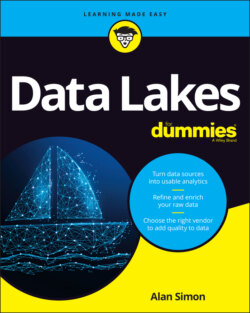Читать книгу Data Lakes For Dummies - Alan R. Simon - Страница 18
Structured data: Staying in your own lane
ОглавлениеYou’re probably most familiar with structured data, which is made up of numbers, shorter-length character strings, and dates. Traditionally, most of the applications you’ve worked with have been based on structured data. Structured data is commonly stored in a relational database such as Microsoft SQL Server, MySQL, or Oracle Database.
FIGURE 1-3: Different types of data in your data lake.
In a database, you define columns (basically, fields) for each of your pieces of structured data, and each column is rigidly and precisely defined with the following:
A data type, such as INTEGER, DECIMAL, CHARACTER, DATE, DATETIME, or something similar
The size of the field, either explicitly declared (for example, how many characters a CHARACTER column will contain) or implicitly declared (the system-defined maximum number for an INTEGER or how a DATE column is structured)
Any specific rules that apply to a data column or field, such as the permissible range of values (for example, a customer’s age must be between 18 and 130) or a list of allowable values (for example, an employee’s current status can only be FULL-TIME, PART-TIME, TERMINATED, or RETIRED)
Any additional constraints, such as primary and foreign key designations, or referential integrity (rules that specify consistency for certain columns across multiple database tables)
